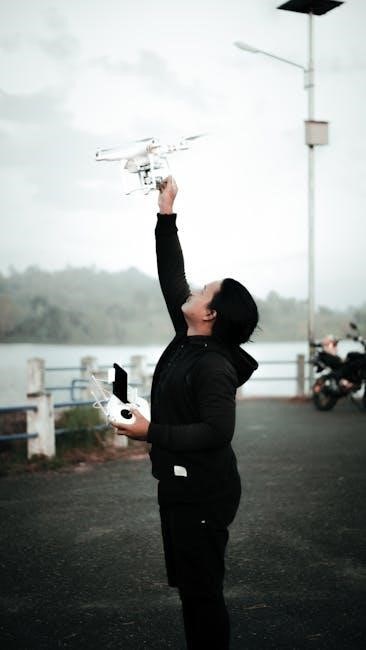hunter pacific remote control instructions
Hunter Pacific Remote Control Instructions: A Comprehensive Guide
This guide offers comprehensive instructions for Hunter Pacific ceiling fan remote controls. It covers everything from initial setup to troubleshooting. Learn about battery installation, dip switch settings, and pairing your remote. Master the functions and maintain your remote for optimal performance.
Hunter Pacific ceiling fans are renowned for their quality and performance, and their remote controls play a vital role in providing convenient operation. These remotes offer users the ability to adjust fan speed, control lighting, and sometimes even reverse the fan’s direction for seasonal comfort, all from the palm of their hand. Understanding the features and functions of your Hunter Pacific remote control is essential for maximizing your ceiling fan’s capabilities.
This comprehensive guide is designed to provide you with all the necessary information regarding Hunter Pacific remote controls. Whether you are a new owner or have been using a Hunter Pacific fan for years, this guide will offer valuable insights into the setup, operation, and maintenance of your remote. We will explore various aspects, including identifying your remote model, installing batteries, setting dip switches, pairing the remote with the fan, understanding the different functions, troubleshooting common issues, and even replacing the remote if necessary.
Additionally, we will discuss integrating wall controls with remote functionality and provide essential warranty information. By the end of this guide, you’ll have a thorough understanding of how to use and maintain your Hunter Pacific remote control, ensuring years of reliable and convenient operation.
Identifying Your Hunter Pacific Remote Control Model
Identifying your Hunter Pacific remote control model is the first crucial step in ensuring you have the correct information for operation, troubleshooting, and replacement. Hunter Pacific offers a range of remote controls, each designed with specific features and compatibility for different fan models.
Typically, the model number can be found on the back of the remote control, often inside the battery compartment. Look for a sticker or imprint that contains a series of numbers and letters, such as “IMCP2” or “FAN53T”. This model number is essential when seeking specific instructions or replacement parts. If the label is worn or missing, consult your fan’s manual, which should list the compatible remote control model.
Another method of identification is by comparing the remote’s appearance and button layout to images available online or in Hunter Pacific product catalogs. Pay close attention to the number of buttons, their arrangement, and any specific symbols or labels. Hunter Pacific’s website often provides visual guides to help you match your remote to the correct model. Once you have identified your remote control model, you can access the appropriate documentation and support resources for your specific device, ensuring you can effectively manage your ceiling fan’s functions.
Initial Setup: Battery Installation and Dip Switch Settings
The initial setup of your Hunter Pacific remote control involves installing batteries and configuring the dip switch settings. Start by locating the battery compartment, typically on the back of the remote. Open the compartment and insert the correct type and number of batteries, usually AA batteries, as indicated inside the compartment. Ensure the batteries are inserted with the correct polarity, matching the “+” and “-” symbols.
Next, access the dip switches, usually located within the battery compartment. These small switches control the radio frequency signal used to communicate with your Hunter Pacific ceiling fan. The dip switch settings in your remote must match those in the fan’s receiver unit. Refer to your fan’s manual for the correct dip switch configuration. If you are unsure, you can try different combinations until the remote successfully controls the fan.

It’s crucial to record your dip switch settings for future reference. This information can be invaluable if you need to reset or replace your remote. Proper battery installation and accurate dip switch settings are essential for establishing a reliable connection between your remote and ceiling fan, ensuring smooth and effective operation.

Pairing or Syncing the Remote with the Fan
Pairing, or syncing, your Hunter Pacific remote with the fan is a crucial step if the remote isn’t responding or after replacing the remote. Begin by restoring power to the fan and ensuring the remote has fresh batteries. Locate the pairing button on the remote receiver unit, often found within the fan’s canopy. This button might be labeled “Learn” or “Sync.”
Press and release the pairing button. Within 30 seconds, press and hold the “High,” “Medium,” and “Low” speed buttons on the remote simultaneously. This action initiates the pairing sequence, sending a signal from the remote to the receiver. Once the fan responds, usually with a light blink or a fan blade movement, the pairing is successful.
Test the remote’s functionality by turning the fan and lights on and off. If the fan doesn’t respond, repeat the pairing process. Ensure you are within close range of the fan during pairing. If issues persist, double-check dip switch settings and battery condition. Successful pairing establishes a secure connection, granting seamless control over your Hunter Pacific ceiling fan.

Understanding Remote Control Functions
Hunter Pacific remote controls typically offer a range of functions designed to enhance comfort and convenience. Familiarizing yourself with these functions is essential for optimal use. The most common functions include fan speed control, allowing you to adjust the fan’s airflow to your preference, often with multiple speed settings (e;g., low, medium, high).
Many remotes also feature light control, enabling you to turn the fan’s light on or off, and sometimes dim it, creating the desired ambiance. Some advanced models include a timer function, allowing you to set the fan to run for a specific duration before automatically turning off, conserving energy. A reverse function, often indicated by a summer/winter icon, changes the fan’s direction to circulate air effectively in both seasons.
Furthermore, some remotes incorporate a “breeze” or “sleep” mode, which varies the fan speed to simulate a natural breeze or provide a comfortable sleeping environment. Power-On-light and buzzer silencing are also included. Understanding these functions empowers you to customize your environment and maximize the benefits of your Hunter Pacific ceiling fan.
Troubleshooting Common Remote Control Issues
Encountering issues with your Hunter Pacific remote control can be frustrating, but many problems can be resolved with simple troubleshooting steps. First, ensure the batteries are fresh and correctly installed, as low battery power is a frequent culprit. If the remote is unresponsive, try re-pairing it with the fan receiver, following the manufacturer’s instructions.
Check the dip switch settings in both the remote and the receiver, ensuring they match. Interference from other devices can also cause issues, so try moving potential sources of interference away from the fan. If the fan wobbles excessively, tighten all screws on the blades and ensure they are properly balanced.
If the light doesn’t work, check the bulb and its connections. For more complex problems, consult the fan’s user manual or contact Hunter Pacific’s customer support for assistance. Remember that a major failure may be due to internal or external defects that existed before installation. Avoid misuse or power surges to protect your warranty.
Replacing the Remote Control
When your Hunter Pacific remote control is lost or damaged, replacing it is a straightforward process. First, identify the model of your existing remote to ensure compatibility with the replacement. Contact Hunter Pacific or an authorized dealer to purchase a new remote control. Before installing the new remote, disconnect power to the ceiling fan.
Install fresh batteries in the new remote and set the dip switches to match the settings of your old remote or the receiver unit in the fan. If the new remote doesn’t have dip switches, follow the pairing instructions to sync it with the fan receiver. Test all functions of the new remote, including fan speed and light control.
If issues persist, consult the troubleshooting section of your fan’s manual or contact Hunter Pacific customer support for guidance. Remember to retain proof of purchase for any warranty claims. It’s also wise to record your remote dip switch settings for future reference.
Wall Control Integration with Remote Functionality
Hunter Pacific ceiling fans often offer the flexibility of both remote and wall control operation. Integrating wall controls with remote functionality allows for convenient control from multiple locations. Hunter Pacific provides specific wall control switches designed to match each fan type. It is crucial to use the wall control supplied with your particular fan model to avoid compatibility issues. These wall controls usually feature speed controlling capacitors tailored to the fan’s motor.
When installing a wall control alongside remote functionality, ensure the wiring is correct, following the installation instructions carefully. Typically, the wall control can be used in conjunction with the remote, providing an alternative method for adjusting fan speed and light settings. In some cases, the wall control can override the remote, offering a master control option.
Always consult the fan’s manual for specific instructions on integrating wall controls and remotes. Verify that the wall control is compatible with the fan’s DC motor if applicable. Proper integration ensures seamless control and prevents damage to the fan or control systems.
Hunter Pacific Remote Control Warranty Information
Hunter Pacific offers a warranty on their remote controls, providing peace of mind for consumers. The warranty typically covers manufacturing defects and malfunctions that occur during normal use. For remote controls supplied as part of a fan, the warranty period and coverage may vary depending on the specific model and purchase date. Hunter Pacific remote controls generally come with a 12-month in-home warranty period for the remote receiver and a 12-month parts-only warranty for the hand piece.
To claim warranty service, you’ll need to provide proof of purchase, product information, and details of the installing electrician. Keep your purchase receipts stapled inside the owner’s manual. The warranty does not cover damage caused by incorrect use, physical abuse, accidental damage, power surges, lightning, weather, or failure to follow maintenance instructions.
Contact Hunter Pacific’s national warranty line at 1300 360 280 for assistance. For online warranty bookings, visit their website. The warranty is only available within Australia. Any modifications or attempts to directly wire the fan without a control module will void the warranty.
General Maintenance for Optimal Remote Performance
Maintaining your Hunter Pacific remote control is essential for ensuring its longevity and optimal performance. Regularly inspect the remote for any signs of damage, such as cracks, loose buttons, or a worn-out battery compartment. Clean the remote’s surface with a soft, dry cloth to remove dust and fingerprints. Avoid using harsh chemicals or abrasive cleaners, as they can damage the finish.
It’s recommended to change the battery in your remote hand piece every 6 months to prevent battery leakages. Battery leakages can cause corrosion and damage the internal components of the remote, leading to malfunction. When replacing the battery, use the correct type and size specified in the user manual.

Store the remote in a cool, dry place away from direct sunlight and extreme temperatures. Avoid exposing the remote to moisture or humidity, as this can cause corrosion and damage. If you won’t be using the remote for an extended period, remove the battery to prevent leakage and corrosion. By following these simple maintenance tips, you can extend the lifespan of your Hunter Pacific remote control and ensure its reliable performance.
Safety Precautions and Installation Guidelines
Prioritize safety when installing and operating Hunter Pacific ceiling fan remote controls. Always disconnect power at the circuit breaker before starting any installation or maintenance work. Follow the wiring diagrams and instructions in the user manual carefully. Ensure all connections are secure and properly insulated to prevent electrical hazards.
Do not attempt to modify or alter the remote control or receiver in any way, as this could damage the components or create a safety risk. Only use genuine Hunter Pacific replacement parts and accessories. If you’re not comfortable working with electrical wiring, consult a qualified electrician for assistance.
Ensure the remote control receiver is installed in a location that is protected from moisture and extreme temperatures. Do not install the receiver in a confined space or where it could be exposed to flammable materials. Keep the remote control out of reach of children and pets. By following these safety precautions and installation guidelines, you can minimize the risk of accidents and ensure the safe and reliable operation of your Hunter Pacific ceiling fan remote control system.
